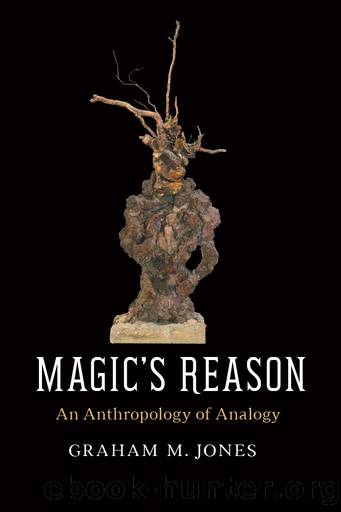Magic's Reason by Graham M. Jones

Author:Graham M. Jones [Jones, Graham M.]
Language: eng
Format: epub
Tags: Social Science, General, Anthropology, Cultural & Social, History, Europe
ISBN: 9780226518718
Google: H-Y8DwAAQBAJ
Publisher: University of Chicago Press
Published: 2017-12-06T04:12:43+00:00
Figure 20. Mediumistic sensation Ira Davenport (left) meets admiring illusionist Harry Houdini (right), 1910. Library of Congress, LC-USZ62-66398.
Houdini was a paradoxical repository for this secret. On the one hand, he wielded his fame and professional credibility as an illusionist as a weapon against Spiritualism. He made the exposure of mediums a personal crusade, attending séances in disguise to confront mediums face to face, and writing a book-length exposé, A Magician among the Spirits (Houdini 1924). Some modern magicians even contend that he was assassinated by Spiritualist operatives (Kalush and Sloman 2006). On the other hand, his feats of unbinding and escape have mystical, even shamanic resonances in the eyes of many scholars (e.g., Mangan 2007: 145â50; Taylor 1985). Some have read his performances through the lens of class conflict, arguing that the muscular physicality of his escapes from prison cells, bank vaults, and straitjackets expressed the wishes of working people to cast off the shackles of carceral capitalism (Cook 2001: 257â58; Mangan 2007: 155â56).15 Perhaps Houdiniâs equivocal status as both myth-buster and myth-maker made him the perfect recipient for the Davenportsâ secret. His renown also gave him a place in the anthropological record: whereas Tylor had referred to the unbinding component of the Shaking Tent complex as âThe Davenport Trick,â by the mid-twentieth century, an anthropologist like Cooper (1944: 66) would be calling it âthe Houdini trick.â
Today, the Spirit Cabinet has become a standard stage magic effect, which I saw performed at least a dozen times during my fieldwork, often in a burlesque register, playfully suggesting a homoerotic sexual situation between a male volunteer invited into the âcabinetâ (a more easily portable curtain is generally used nowadays) and the male magician-medium.16 Some performers made tongue-in-cheek allusions to Hollywood horror movies, framing the performance as a supernatural spoof. Alain, the Afro-Antillean magician I mention in the introduction, accompanied his rendition of the effect with quips about âIsland voodoo,â playing with French audiencesâ stereotypes about the Caribbean.
Ultimately, the ironic, playful, and fundamentally skeptical stance toward the paranormal implicit in these contemporary renditions of the Spirit Cabinet by Parisian illusionists seems to starkly contrast with the way that anthropologists traditionally imagined the solemnity of rituals like the Shaking Tent. But, as my discussion of Tylor and his commentators shows, the self-reflexivity of the modern magic assemblage has been a foil against which anthropology has historically constructed ideas about the enchantedness of ritual and fallacy of artifice. So much so that it can be difficult to infer from the ethnographic record what the Shaking Tent once might have been without the imposition of the adventitious analogue of stage magic. In the next chapter, I describe in greater detail how the discipline has contended directly and indirectly with this beguiling analogy, reworking theories of magic while, in the process, developing new approaches to cross-cultural comparison.
Download
This site does not store any files on its server. We only index and link to content provided by other sites. Please contact the content providers to delete copyright contents if any and email us, we'll remove relevant links or contents immediately.
| Belgium | France |
| Germany | Great Britain |
| Greenland | Italy |
| Netherlands | Romania |
| Scandinavia |
Room 212 by Kate Stewart(4125)
The Crown by Robert Lacey(4122)
Endurance: Shackleton's Incredible Voyage by Alfred Lansing(3863)
The Iron Duke by The Iron Duke(3659)
The Rape of Nanking by Iris Chang(3535)
Killing England by Bill O'Reilly(3470)
Joan of Arc by Mary Gordon(3275)
Say Nothing by Patrick Radden Keefe(3078)
I'll Give You the Sun by Jandy Nelson(2851)
Shadow of Night by Deborah Harkness(2750)
Hitler's Monsters by Eric Kurlander(2741)
Margaret Thatcher: The Autobiography by Thatcher Margaret(2692)
Mary, Queen of Scots, and the Murder of Lord Darnley by Alison Weir(2683)
Darkest Hour by Anthony McCarten(2656)
Blood and Sand by Alex Von Tunzelmann(2617)
Red Famine: Stalin's War on Ukraine by Anne Applebaum(2473)
Eleanor & Park by Rainbow Rowell(2402)
The One Memory of Flora Banks by Emily Barr(2358)
Book of Life by Deborah Harkness(2287)
